|
|
|
|
|
|
|
|
|
"Continuous" or "simple" seam technique, prevailing in NW Russia (reconstructions and archaeological finds) .
(See also techniques overview)
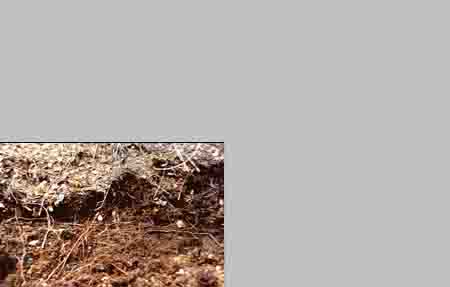 Full scale image (32Kb)
Full scale image (32Kb)Spruce roots in the ground; so they look when upper layer of soil and fallen needles is raked away For the sewing material roots of coniferous trees (spruce or pine) were most commonly taken; they were the cheapest and most available stuff -- in a dark coniferous forest soil is so loose and grassless that one can easily pick the roots up with bare hands, using only a knife to cut them. Broad leaf tree roots (such as birch roots) were also taken sometimes, but they are probably harder to obtain, a birch forests usually have firm layer of grassy turf. One can collect enough spruce roots for a small boat (~100 meters) in one or two days, provided that a rich spot was found. The optimal root thickness lies between 1/3 and 1/2 of the planking thickness, while the root can reach 2-3 meters length. As soon as the roots were picked up, one has to keep them from getting dry and crisp, -- immerse them either in water or tar. Some say they were boiled in water right with the bark, the latter peels off easier after boiling; another tradition says they are to be boiled in tar, to make them rot resistant. In any case roots are to be barked and twisted like withies, which partially laminates them into fibers and makes them flexible -- a well twisted root can be tied into a hard knot without breakage. This withe twisting is a sort of manual art, that can only be acquired by experience and not from theoretical explanation. Apart from spruce, some other species roots were used, like juniper, pine, birch, etc., as well as twisted slender shoots off the same juniper, birch, hazel, willow, or young spruce's stems. |
|
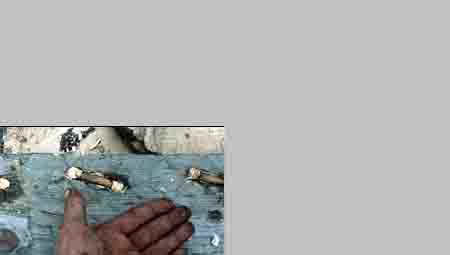
Full scale image(26Kb) The shnjaka reconstruction stitches -- twisted spruce root 8-12 mm thick. Summer 2001. |
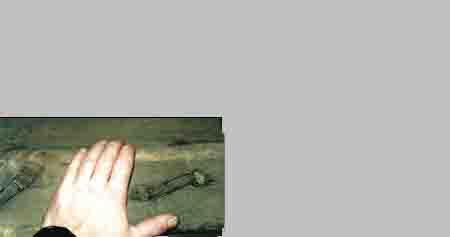
Full scale image (21Kb) Skeppargatan ship stitches - a big sewn ship found in Stockholm. Material - twisted spruce withy ~20 mm in diameter. Such thick withies could be just twisted stems of young spruces 1-2 meters high, and not roots. The find dated around 1700. |
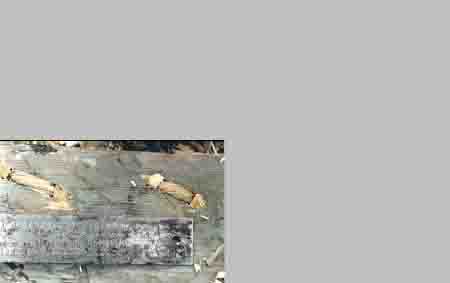
Full scale image (34Kb) The shnjaka reconstruction stitches. Summer 2001. |
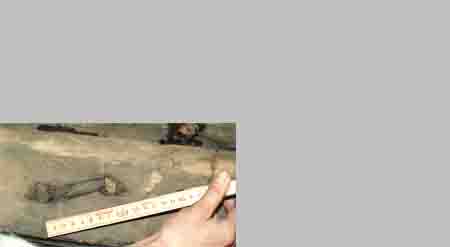
Full scale image(23Kb) Skeppargatan ship stitches. |
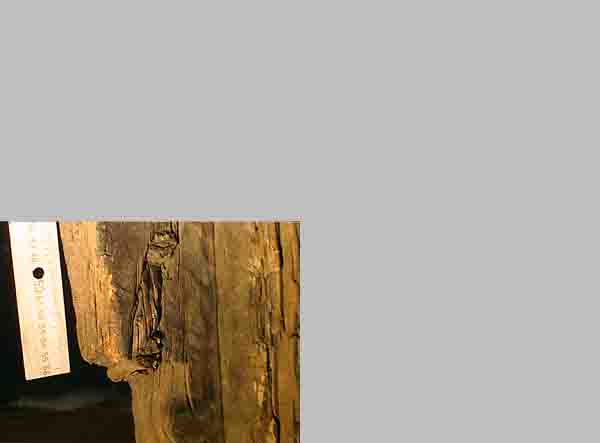 Full scale image(85 Кб)
Full scale image(85 Кб)Stitch in a planking fragment, found in one of Solovetski cloister's buildings when repairing floor. Probably from 17-18th century. Material -- ligneous withy, apparently spruce. Photo 2005. |
|
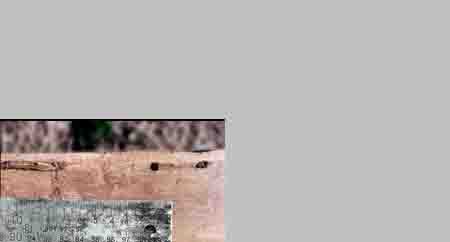
Full scale image (24Kb) A stitch, preserved in a plank fragment (presumably beginning of 20th century), found at Vodlozero lake, Russian Carelia . Sewing material was not reliably identified - either spruce or juniper twisted root or withy. |
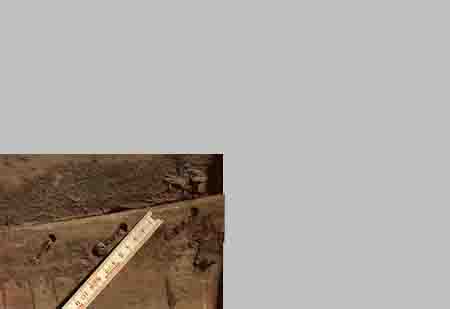
Full scale image (32Kb) Stitches in Saami boat from Notozero village near Kandalaksha, build in 1909. Sewing material - linden bast rope. |
 Full scale image (27Kb)
Full scale image (27Kb)Seam in a plank fragment, found at Vodlozero lake. Short pieces (no longer then 70cm) of sewing material were used, allowing only 5 stitches in row. This can indicate to probable material - juniper withy. |
|
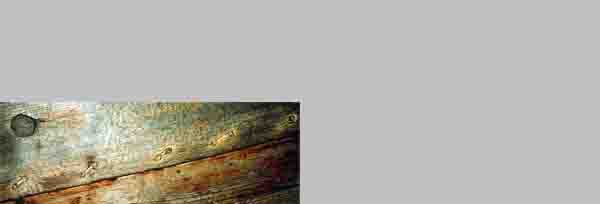 Full scale image (33Kb)
Full scale image (33Kb)Seam on Kola shnjaka built in 1905(?). Sewing material is gone in most places, the ship underwent total repair with metal nails and rivets. Just plugged sewing holes and stitch grooves between them are visible here. |
|
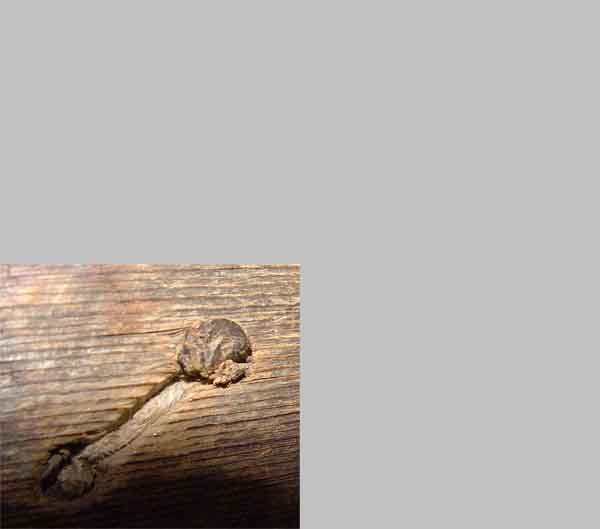 Full scale image(81Kb)
Full scale image(81Kb)Same as above, Kola shnjaka built in 1905(?)., One of the few preserved stitches, sewing material -- hemp(?) twine is visible. |
|
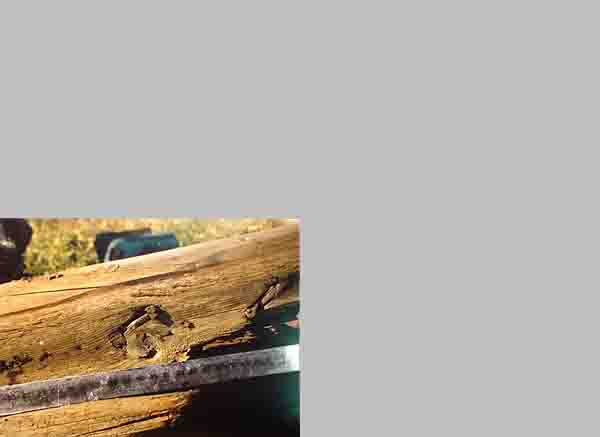 Full scale image(97 Кб)
Full scale image(97 Кб)Fragment of sewn planking together with a knee, found on cape Kuzokotski, White sea, in 2005. Ligneous withy, tree species unknown. |
|
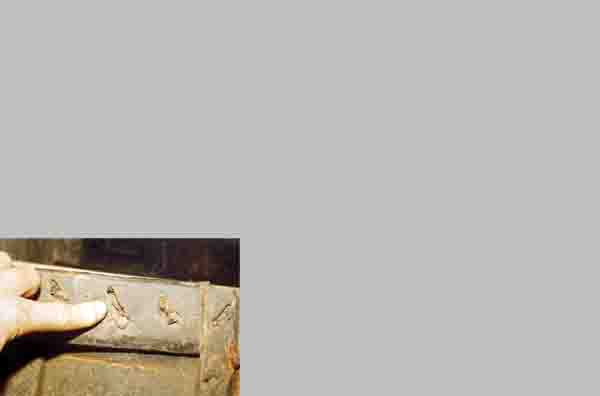 Full scale image(66 Кб)
Full scale image(66 Кб)Light boat for seal hunt on ice fields. It has expanded dugout bottom and two cravel strakes, sewn to thin close set ribs. Stitch material -- hemp (?) twine. Photo 2005. |
|
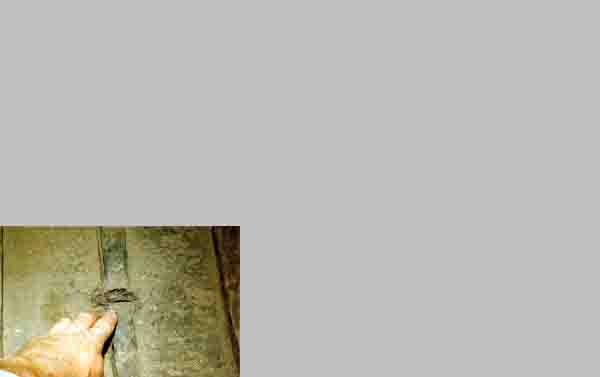 Full scale image(76 Кб)
Full scale image(76 Кб)Same boat as above. It has sledge runners on the bottom for dragging over ice, which are lashed with much thicker ligneous withy (species unknown). Photo 2005. |
|
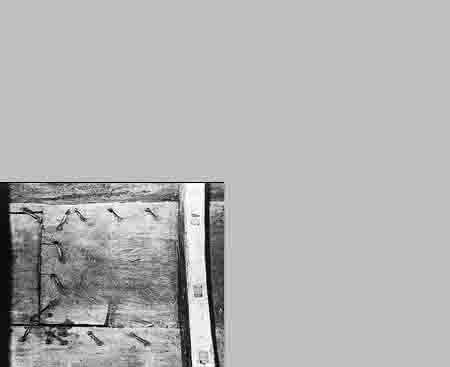 Full scale image (34Kb)
Full scale image (34Kb)Sewing on the Lapp boat built in 1871, exhibited in Tromsø museum in Norway. Material - hemp(?)twine. Photo: A.E.Christensen. |
|
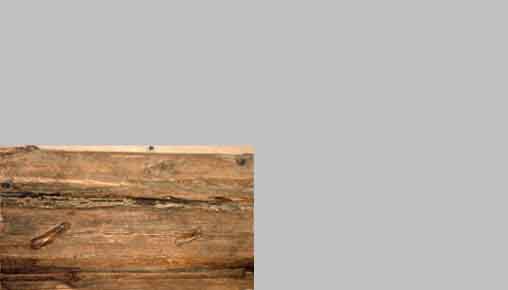 Full scale image (55Kb)
Full scale image (55Kb)Planking fragment from Mangazeya, with ligneous withy sewing. 17-18 century. Exhibited in in Polar museum in S-Petersburg. |
|
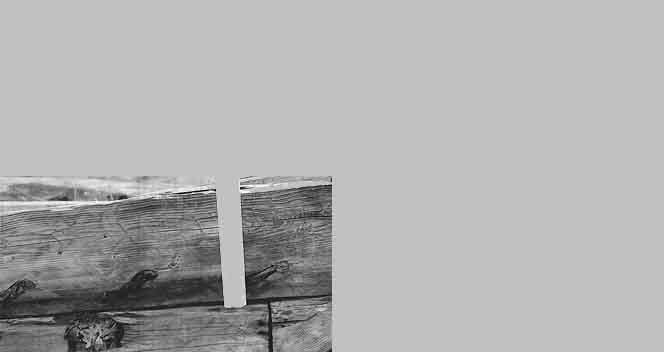 Full scale image (87Kb)
Full scale image (87Kb)Find at Pyranikha, North Dvina estuary, 1991. Ligneous withy. Photo: Pavel Rozmanov. |
|
Consequent stages of laying a stitch
(Pictures of these consequent stages taken while building a "vodlosjorka" at Foteviken in 1999.)
When a strake was finally fitted and mounted by means of wedged clamps, a row of holes is to be drilled through the overlapping part of the clinker planking. The row must go in zigzags to avoid the single wood grain line and reduce the hazard of cracks. Also, the holes are to be drilled obliquely to the plank surface, to make the root bends smoother. Then grooves are to be cut between the holes with a knife, the outer stitch parts will be later sunk into these grooves. Optimal hole diameter fells between 1/3-1/2 of the strake's thickness, the groove depth - between 1/4-1/3 of the strake's thickness. Twisted root is to be fed trough several holes in row, just like a thread in a simple tailor's seam; the root's end is to be fixed in the first hole by wedging with a treenail. These treenails will also plug the holes and make them watertight; they were traditionally made of alder wood in Carelia. Then the root loop between second and third holes is to be hooked with an especial T-shaped tool, (resembling a wooden hammer), and tightened as hard as possible. The T-shaped tool acts like a lever, butted against the plank surface, and several root loops between sewing holes act like folds of cable on a polyspaste (the root is slippery enough to slide in the holes), multiplying the force which presses strakes together. While holding the root tightened, one have to fix it in a next hole by hammering a treenail into it. Then the next loop is to be hooked and tightened, the treenail hammered into the next hole, and so forth. Nothing especial is needed when the root's end was reached - it is just fixed in its hole as usual, a new root starts from the next hole. This joint is no weaker then conventional modern nails and rivets, but a lot more labor consuming: it takes about an hour to sew up one meter.
|
|
|
|
|
|
|
|
|
last update: December 2006 report problems with this page to ![]()